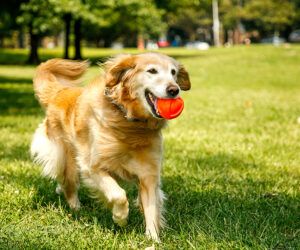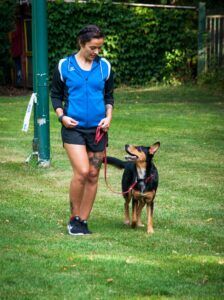I’m going to start by talking about something that a lot of dog owners experience but might not fully understand: hyperactivity and anxiety in their furry friends. You’re going to find out about why some dogs just seem to have endless energy and why others might seem stressed or anxious a lot of the time.
experience but might not fully understand: hyperactivity and anxiety in their furry friends. You’re going to find out about why some dogs just seem to have endless energy and why others might seem stressed or anxious a lot of the time.
It’s a fact that dogs, like people, can exhibit a range of behavior when it comes to activity levels and anxiety. Some dogs are laid back and calm, while others are like furry tornadoes, dashing around and seeming to never run out of steam. And in some cases, what might seem like boundless energy is actually a sign of underlying anxiety.
Certain breeds are more prone to hyperactivity, stress, and anxiety. For example, working breeds, herding dogs, and some terriers are known for their high energy. It’s in their genes to be active, and without the right outlet, this energy can manifest as what we call hyperactivity or anxiety.
Signs of anxiety in dogs aren’t always obvious. It’s not just about a dog being scared during a thunderstorm—it can also be seen in behaviors like destroying items, excessive panting, or even changes in appetite. Recognizing these signs is the first step in helping your anxious or hyperactive pooch.
Breed tendencies provide valuable clues when planning the care and management of our dogs. Herding breeds for example, such as Australian shepherds, need lots of exercise and mental stimulation to keep them balanced. On the other end, sighthounds like greyhounds might give off a laid back vibe but can bolt with explosive energy when motivated.
Now that we’ve touched on the ‘why’ of hyperactive and anxious behaviors in dogs, let’s move onto the ‘how’—how to calm down your animated pup using natural remedies. This isn’t just about giving your dog something to do; it’s also about ensuring they’re emotionally stable and happy.
Natural Remedies for Calming Hyperactive Dogs
If you’re grappling with a hyperactive furball who can’t seem to settle down, don’t worry too much about it; there are natural ways to help your dog achieve a state of calm. That’s going to include a variety of strategies from exercise to massage, and even calming clothes.
Let’s start with **exercise**. It’s no secret that a tired dog is typically a well-behaved dog. But, did you know that the type and amount of exercise can vary greatly by breed and age? It’s not just about physical exertion; mental stimulation is just as crucial. Activities like fetching, tug-of-war, and hide-and-seek tap into your dog’s physical and cognitive cap abilities, channeling their energy in a positive way.
abilities, channeling their energy in a positive way.
Now, onto **massage**. It might seem a bit indulgent, but trust me, it has substantial benefits. Massaging your dog not only helps them relax but also strengthens your emotional connection. Simply petting your dog in a purposeful way can ease their tension and yours.
The market for **calming supplements** has expanded significantly in recent years, and for a good reason. These often contain ingredients like melatonin, which is known to promote sleep, or CBD, which is touted for its calming effects. Though they should not be a first-line solution, calming supplements can be a helpful addition to your dog’s routine, especially during more stressful times.
What about music? Yes, playing certain types of music or white noise can help block out the external sounds that could be stressing your dog. It creates a tranquil environment and can be especially helpful during events notorious for causing anxiety, like thunderstorms or fireworks.
Lastly, let’s talk about **calming clothes**. Much like weighted blankets for humans, these garments apply gentle, constant pressure to your dog’s body, promoting relaxation. They’re a simple, drug-free way to help keep your dog’s anxiety at bay.
Keep in mind that while these methods can be incredibly beneficial, they’re not a cure-all. Dogs, just like people, are individuals with their own preferences and needs. Choose something that resonates with your dog, and don’t be afraid to try different approaches to find what works best. Now, in cases where natural remedies aren’t quite cutting it, it’s time to consider the next step: medication. And that’s where Section 3 of our guide will take you.
When to Consider Medication for Anxious Canines
So you’ve tried the soothing melodies and the snug-fitting shirts, and while those work wonders for some, we don’t live in a one-size-fits-all world. Some dogs may still display signs of anxiety that are too big of a beast for natural remedies alone to tackle. That’s when it might be time to pivot to a different tactic.
This isn’t just about calming your dog; it’s about quality of life. So if you’ve given the massages, the music, and the mental exercises a fair shot without much success, consider having a heart-to-heart with your vet. They’re equipped to assess whether your buddy could benefit from medication, and if so, which type would suit them best.
Antidepressants, like amitriptyline or fluoxetine, aren’t limited to humans; they can also help dogs with severe anxiety. It’s not a decision to make lightly, though, and your vet will want to ensure they’re used responsibly. These meds can help rewire the stress responses in your dog’s brain, fostering a more tranquil state of mind over time.
Now, for the scenarios that get your furry friend’s tail in a twist – thunderstorms, fireworks, the dreaded vacuum cleaner – sedatives such as Xanax or gabapentin might be the answer. They’re often reserved for those specific situations that wind your dog up to eleven. Again, this is a chat for you and your vet, as these medications require proper dosing and monitoring for safety.
Remember, turning to medication isn’t a defeat. It’s an act of compassion for a friend in distress. And it’s essential to combine these treatments with the strategies you’re going to learn about next. Medications may help manage symptoms, but a holistic approach that includes training and environmental management typically yields the best outcomes.
Behavioral Strategies for Managing Hyperactive Dogs
Turning mealtime for your hyperactive dog into a challenge can be a game-changer. By hiding their food in treat pouches or integrating training commands with feeding, you’re going to make them use their brains while they fill their bellies. This not only burns extra energy but also adds structure to what could be a hyperactive moment.
On top of that, ‘work for everything’ isn’t just a mantra, it’s an effective strategy for hyper dogs. Whether it’s sitting before going outside or performing a trick before getting a treat, consistent task-reward patterns can make a big difference in curbing impulsive behaviors.
Ever considered how powerful your dog’s nose is? Nose work is a fantastic way to engage their mind by letting them sniff out treats or specific scents. It turns their natural curiosity into a calming and focused exercise.
Mealtime puzzles serve as an excellent tool to slow down eaters and provide mental stimulation. They are especially useful for dogs that gulp their food too fast, which can lead to digestive issues on top of their hyperactivity. Interactive feeding not only entertains but also teaches patience and problem-solving skills.
And let’s not forget the thrill of canine sports. Agility, dock diving, obedience training, flyball, and disc dog are exhilarating ways to help burn off steam. These activities not only tire out your active pooch but also strengthen your bond and can even showcase your dog’s natural talents.
Comprehensive Care: Addressing Physical and Mental Well-being
You’ve now got a pretty good grasp on managing hyperactive and anxious dogs. Remember, it’s about balance: ensuring your furry friend gets both the physical outlet and the mental gymnastics they need. This isn’t just about tuckering them out with a game of fetch; it’s also about engaging their minds and catering to their instincts.
Breeds do matter. Herding dogs might go bananas without a job to do, while sporting dogs could become your best running buddy. Knowing your dog’s breed-specific tendencies can be the key to unlocking their best behavior and overall happiness.
While we’ve circled around natural and behavioral strategies, don’t overlook the value of a thorough medical evaluation, especially if you’ve tried all the tricks in the book and your dog is still bouncing off the walls or cowering under the bed. Persistent anxiety or hyperactivity could be a sign of underlying issues that a professional needs to address.
In my opinion, watching a hyperactive dog transform into a poised and content companion is incredibly rewarding. With patience, consistent training, and a healthy dose of creativity in how you approach both exercise and mental stimulation, you can make a significant impact on your dog’s quality of life.
So, choose something that resonates with you and your dog. Not every method will be a slam dunk, but you can always adjust your approach down the road. I really hope that you enjoy this journey as much as your dog will. And remember, while the path to a calm and happy dog can be winding, it’s one filled with shared experiences and bonding that will make every step worth it.

